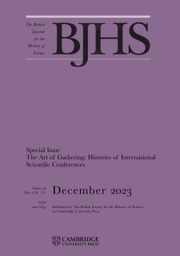Paul Warde, Libby Robin and Sverker Sörlin's book is a sweeping history of the idea of environment. Reaching back and looking ahead, this history focuses on the fifty-plus years after the Second World War, a period not only characterized by further urbanization, by uneven growth of population and economies, and by the consequential unprecedented human impact on the environment, but also by a new ‘world-mindedness’ (p. 1) that encompassed ‘a new unifying power’ (p. 24). The authors, whose scholarship has significantly shaped environmental history for more than a generation, explain that the environment was a concept both of crisis and of peacetime, born out of a sense of urgency during the post-war period, a political concept that ultimately became policy mainstream.
Readers are taken on a rollercoaster ride through this half-century, bracketed on the one side by two American publications from 1948, Road to Survival by ecologist William Vogt, and Our Plundered Planet by conservationist Fairfield Osborn, and on the other by the 1992 UN Earth Summit in Rio and the meetings thereafter. To keep us oriented and in our seats throughout the seven-chapter narrative unfolding during the Cold War, the authors use four key themes: futures thinking, scientific expertise, quantification – what Theodor Porter has called ‘trust in numbers’ – and scale and scalability.
The first two chapters introduce the state of the Earth in the immediate postwar years and what environment meant before its understanding became an international, global and finally planetary concept. The authors move from Thomas Carlyle to Herbert Spencer, revealing the legacy of Spencer's ideas of the environment in the thinking of various influential nineteenth-century researchers and intellectuals. Throughout the nineteenth century, environment was used to describe surroundings, mostly of individual organisms or entities. Although this continues to be one of the term's meanings, in the postwar years environment came to describe a unified interconnected system that was threatened. International conferences were held and a suite of new international organizations began to collect data, investigate the workings of the system and implement measures to conserve resources, and to protect species and natural and cultural heritage.
The shapers of this new understanding of environment were scientists. In Chapter 3, the authors show how these new experts used new technologies, especially computers, to analyse data and to generate scenarios and predictions, including the well-known Limits to Growth (1972) report. Increased consumption and population growth sparked anxieties about life on Earth generally, and especially about resources, including the predicament of peak oil. The world appeared caught up in the Jevon's paradox – which observes that increases in efficiency are commonly offset by increases in consumption – as it was unclear whether more efficient technologies would reduce consumption and environmental harm. Techno-optimists opposed doomsayers.
The role of ecologists and ecosystem science in these developments is the topic of Chapter 4. The authors show how ecologists such as the brothers Eugene and Howard Odum conceived of the world in terms of nutrient and energy flows, setting the basis for ecology and conservation biology's increasing trust in numbers. Beginning in the 1970s, this led to the translation of nature's values into what in economic contexts today are called ecosystem services. In Chapter 5, the authors reveal how, in the 1980s and 1990s, climate became a more conscious part of the environment. As climate change and its anthropogenic causes became increasingly manifest, the idea of disturbance in ecology superseded that of balance; in evolutionary theory, the new frames of thought were disaster instead of development, and revolution rather than evolution. In terms of the economy and society at large, thinking in terms of transition and transformation became critical. The sixth chapter begins with the 1987 Brundtland report Our Common Future and dwells once more on the role of scientists in crafting international networks that were important for nations to realize their environmental interdependence and the need for global thinking as well as national and local action. In their final chapter, the authors show how yet another scientific field, earth system science, ‘a science that aimed to get things done’ (p. 159), contributed meaningfully to this endeavour of scaling, not least through its new modelling abilities.
The thesis that the environment demanded ‘interdisciplinary and multifaceted knowledge-making and understanding on many scales’ (p. 4) will be well known to critical and well-grounded professionals dealing with the shaping and planning of that same environment today (such as, urban, landscape and regional planners and designers). The book nevertheless adds to our understanding of the processes, pitfalls and opportunities these activities entail. By offering a history of the institutional and scientific frameworks of environment, within which humanities scholars, professionals and artists have navigated various scales to apply their imagination and vision, the book points to these ‘experts’ who are largely left out of this narrative. As the authors conclude, their history calls for ‘‘‘more-than-expertise’’, for participatory decision making’ (p. 169), and for conceiving the environment as ‘a matter of imagination as well as information, equally among scientists as among nonscientists’ (p. 177).
The book is an addition to the authors’ anthology of historical sources compiled in The Future of Nature: Documents of Global Change (2013). It is among several recent books that, inspired by discussions about the Anthropocene, have sought to shed light on its conceptual foundations, including conservation and preservation, sustainability, ecological modernization and ecosystem services, alongside environment. Among these are Paul Warde's The Invention of Sustainability (2018) and Etienne Benson's Surroundings (2020), both of which take us further back in time and home in on relevant details and nuances related to the complex histories of the concept of environment.
The Environment is suitable for scholars seeking a first grasp on the environment in the twentieth century, and its genealogy. It is an excellent introduction to the many environmental concerns and how we humans have sought to manage them, especially through international and national institution building. The paperback is a nicely produced, handy and lightweight artefact that enlightens a hefty topic.



